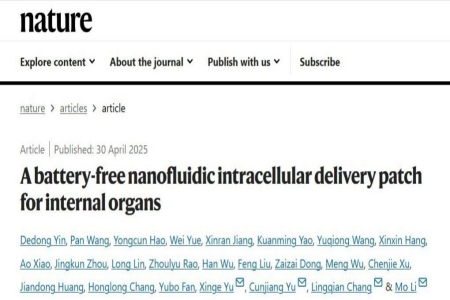Li Mo’s Team from PKU Third Hospital and Collaborators Publish Findings in Nature
On April 30, 2025, Professor Li Mo’s team from Peking University Third Hospital (PKUTH), in collaboration with Professor Lingqian Chang's team from Beihang University, Professor Cunjiang Yu's team from the University of Illinois Urbana-Champaign, and Professor Xinge Yu’s team from City University of Hong Kong, published a paper titled “A Battery-Free Nanofluidic Intracellular Delivery Patch for Internal Organs” online in Nature . Through an interdisciplinary “medical-engineering-chemical” approach, the study achieved breakthroughs in screening key factors for major diseases and proposed novel targeted therapeutic strategies.

The NanoFLUID patch developed by the team adopts a flexible design without batteries or chips. Its mechanical properties match those of soft visceral organ tissues, allowing it to seamlessly adhere to the surfaces of organs such as the liver and breast, enabling highly customized targeted delivery. Its unique “nanopore-microchannel-microelectrode” structure, through the synergistic effect of microscale fluid dynamics regulation and electric fields, can safely and efficiently electroporate cell membranes under low voltage (only 10V), increasing the intracellular delivery efficiency of drugs or genes by up to tens of thousands of times compared to traditional diffusion methods.
Experimental results confirm that this technology causes less than 5% impact on cell viability, while making possible delivery regulation at the single-cell precision level. This technology not only breaks through the physical and biological barriers of traditional delivery methods but also achieves a qualitative leap in precision and controllability, providing a quantifiable and programmable new technical platform for organ-targeted therapy.
What is particularly important is that the team innovatively adopted the NanoFLUID-mediated gene library co-transfection technology to systematically screen and define key drivers of breast cancer metastasis at the in vivo level. Through high-throughput sequencing and bioinformatics analysis, the lung-specific metastasis driver gene DUS2 was discovered for the first time. This gene significantly promotes the colonization and growth of tumor cells in the lungs by enhancing the translation efficiency of proteins in tumor cells (including more than 70 metastasis-related proteins). This discovery not only reveals the molecular mechanism of organ tropism in tumor metastasis but also provides a brand-new approach for developing specific therapeutic targets against different metastatic foci.
Written by: Wu Zhaoxia
Edited by: LiuXin
Source: Peking University Third Hospital


